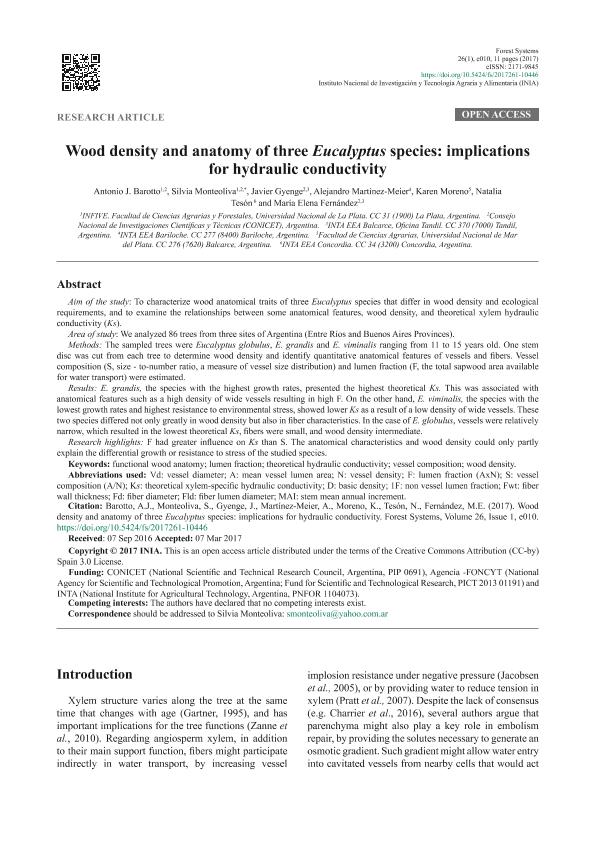Artículo
Wood density and anatomy of three Eucalyptus species: implications for hydraulic conductivity
Barotto, Antonio José ; Monteoliva, Silvia Estela
; Monteoliva, Silvia Estela ; Gyenge, Javier Enrique
; Gyenge, Javier Enrique ; Martinez Meier, Alejandro; Moreno, Karen Gabriela; Tesón, Natalia; Fernandez, Maria Elena
; Martinez Meier, Alejandro; Moreno, Karen Gabriela; Tesón, Natalia; Fernandez, Maria Elena
 ; Monteoliva, Silvia Estela
; Monteoliva, Silvia Estela ; Gyenge, Javier Enrique
; Gyenge, Javier Enrique ; Martinez Meier, Alejandro; Moreno, Karen Gabriela; Tesón, Natalia; Fernandez, Maria Elena
; Martinez Meier, Alejandro; Moreno, Karen Gabriela; Tesón, Natalia; Fernandez, Maria Elena
Fecha de publicación:
05/2017
Editorial:
Instituto Nacional de Investigación y Tecnología Agraria y Alimentaria
Revista:
Forest systems
ISSN:
2171-9845
Idioma:
Inglés
Tipo de recurso:
Artículo publicado
Clasificación temática:
Resumen
Aim of the study: To characterize wood anatomical traits of three Eucalyptus species that differ in wood density and ecological requirements, and to examine the relationships between some anatomical features, wood density, and theoretical xylem hydraulic conductivity (Ks). Area of study: We analyzed 86 trees from three sites of Argentina (Entre Ríos and Buenos Aires Provinces). Methods: The sampled trees were Eucalyptus globulus, E. grandis and E. viminalis ranging from 11 to 15 years old. One stem disc was cut from each tree to determine wood density and identify quantitative anatomical features of vessels and fibers. Vessel composition (S, size - to-number ratio, a measure of vessel size distribution) and lumen fraction (F, the total sapwood area available for water transport) were estimated. Results: E. grandis, the species with the highest growth rates, presented the highest theoretical Ks. This was associated with anatomical features such as a high density of wide vessels resulting in high F. On the other hand, E. viminalis, the species with the lowest growth rates and highest resistance to environmental stress, showed lower Ks as a result of a low density of wide vessels. These two species differed not only greatly in wood density but also in fiber characteristics. In the case of E. globulus, vessels were relatively narrow, which resulted in the lowest theoretical Ks, fibers were small, and wood density intermediate. Research highlights: F had greater influence on Ks than S. The anatomical characteristics and wood density could only partly explain the differential growth or resistance to stress of the studied species.
Archivos asociados
Licencia
Identificadores
Colecciones
Articulos(CCT - MAR DEL PLATA)
Articulos de CTRO.CIENTIFICO TECNOL.CONICET - MAR DEL PLATA
Articulos de CTRO.CIENTIFICO TECNOL.CONICET - MAR DEL PLATA
Citación
Barotto, Antonio José; Monteoliva, Silvia Estela; Gyenge, Javier Enrique; Martinez Meier, Alejandro; Moreno, Karen Gabriela; et al.; Wood density and anatomy of three Eucalyptus species: implications for hydraulic conductivity; Instituto Nacional de Investigación y Tecnología Agraria y Alimentaria; Forest systems; 26; 1; 5-2017; 1-11
Compartir



